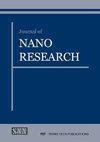Facile Synthesis of Hydrophobic Thermal Insulation Nano-TiO2/ZnO and SnO Coating for Solar Cell
IF 1
4区 材料科学
Q4 MATERIALS SCIENCE, MULTIDISCIPLINARY
引用次数: 0
Abstract
The solar light radiation causes some of the heat to be trapped inside the solar cell that raises the solar cell’s temperature, then reduces the electrical efficiency of the overall system. The thermal radiation from solar light causes overheating on the solar cell surface and degrades its functionality. In this study, the thermal insulation coating has been proposed to prevent interior trapped heat. Different nanocoating systems have been developed using nano-Titanium Dioxide (TiO2) namely T1B2 and T2B2, nano-Zinc Oxide (ZnO) namely Z1B2 and Z2B2 and nano-Tin Oxide (SnO) namely S1B2 and S2B2. All the nanoparticles have been synthesized at various weight percentages which are 20wt.% and 60wt.% in the B2 binder system, Methyltrimethoxysilane (MTMS) / nitric acid (HNO3). The incorporation of nanoparticles increases the hydrophobicity of binder coating in which the Water Contact Angle (WCA) of coating improves up to 105°. The embedded nanoparticles increase the surface roughness, then reduce the contact of water to the substrate’s surface. Apart from that, the coating is also capable to halt the drastic increment in surface temperature. The result has shown that the B2 binder coating increases the surface temperature of solar cell by 2.54°C after 1hr of Xe 1000 W/m2 irradiation. The raise in temperature is due to the strong oxidation of nitric acid. However, the incorporation of nano-ZnO and nano-SnO in B2 binder matrix capable to reduce the temperature of the solar cell. The wide bandgap of both nanoparticles induces good stability of coating at high operating temperature. The Z1B2 and S2B2 has reduced the temperature of solar cell by 7°C and 3°C, indicating their great thermal insulation property for solar cell application.太阳能电池用疏水隔热纳米tio2 /ZnO和SnO涂层的简易合成
太阳光辐射导致一些热量被困在太阳能电池内部,提高了太阳能电池的温度,然后降低了整个系统的电力效率。来自太阳光线的热辐射导致太阳能电池表面过热并降低其功能。在这项研究中,提出了隔热涂层,以防止内部的热量滞留。纳米二氧化钛(TiO2)即T1B2和T2B2,纳米氧化锌(ZnO)即Z1B2和Z2B2,纳米氧化锡(SnO)即S1B2和S2B2,已经开发出了不同的纳米涂层体系。所有的纳米颗粒都以不同的重量百分比合成,这些重量百分比为20wt。%和60wt。%在B2粘结剂体系中,甲基三甲氧基硅烷(MTMS) /硝酸(HNO3)。纳米颗粒的掺入提高了粘结剂涂层的疏水性,涂层的水接触角(WCA)可达105°。嵌入的纳米颗粒增加了表面粗糙度,然后减少了水与基材表面的接触。除此之外,涂层还能够阻止表面温度的急剧上升。结果表明,在Xe 1000 W/m2照射1hr后,B2粘结剂涂层可使太阳电池表面温度提高2.54℃。温度升高是由于硝酸的强烈氧化。然而,在B2粘结剂基体中掺入纳米zno和纳米sno能够降低太阳能电池的温度。两种纳米粒子的宽带隙使得涂层在高温下具有良好的稳定性。Z1B2和S2B2分别使太阳能电池的温度降低了7℃和3℃,表明其具有良好的隔热性能,可用于太阳能电池的应用。
本文章由计算机程序翻译,如有差异,请以英文原文为准。
求助全文
约1分钟内获得全文
求助全文
来源期刊

Journal of Nano Research
工程技术-材料科学:综合
CiteScore
2.40
自引率
5.90%
发文量
55
审稿时长
4 months
期刊介绍:
"Journal of Nano Research" (JNanoR) is a multidisciplinary journal, which publishes high quality scientific and engineering papers on all aspects of research in the area of nanoscience and nanotechnologies and wide practical application of achieved results.
"Journal of Nano Research" is one of the largest periodicals in the field of nanoscience and nanotechnologies. All papers are peer-reviewed and edited.
Authors retain the right to publish an extended and significantly updated version in another periodical.
 求助内容:
求助内容: 应助结果提醒方式:
应助结果提醒方式:


